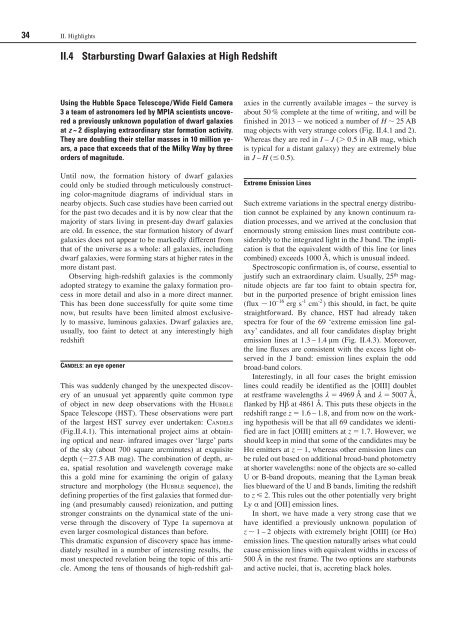Annual Report 2011 Max Planck Institute for Astronomy
Annual Report 2011 Max Planck Institute for Astronomy
Annual Report 2011 Max Planck Institute for Astronomy
Create successful ePaper yourself
Turn your PDF publications into a flip-book with our unique Google optimized e-Paper software.
34 II. Highlights<br />
II.4 Starbursting Dwarf Galaxies at High Redshift<br />
Using the Hubble Space Telescope/Wide Field Camera<br />
3 a team of astronomers led by MPIA scientists uncovered<br />
a previously unknown population of dwarf galaxies<br />
at z ~ 2 displaying extraordinary star <strong>for</strong>mation activity.<br />
They are doubling their stellar masses in 10 million years,<br />
a pace that exceeds that of the Milky Way by three<br />
orders of magnitude.<br />
Until now, the <strong>for</strong>mation history of dwarf galaxies<br />
could only be studied through meticulously constructing<br />
color-magnitude diagrams of individual stars in<br />
nearby objects. Such case studies have been carried out<br />
<strong>for</strong> the past two decades and it is by now clear that the<br />
majority of stars living in present-day dwarf galaxies<br />
are old. In essence, the star <strong>for</strong>mation history of dwarf<br />
galaxies does not appear to be markedly different from<br />
that of the universe as a whole: all galaxies, including<br />
dwarf galaxies, were <strong>for</strong>ming stars at higher rates in the<br />
more distant past.<br />
Observing high-redshift galaxies is the commonly<br />
adopted strategy to examine the galaxy <strong>for</strong>mation process<br />
in more detail and also in a more direct manner.<br />
This has been done successfully <strong>for</strong> quite some time<br />
now, but results have been limited almost exclusively<br />
to massive, luminous galaxies. Dwarf galaxies are,<br />
usually, too faint to detect at any interestingly high<br />
redshift<br />
CandelS: an eye opener<br />
This was suddenly changed by the unexpected discovery<br />
of an unusual yet apparently quite common type<br />
of object in new deep observations with the HuBBle<br />
Space Telescope (HST). These observations were part<br />
of the largest HST survey ever undertaken: CaNdelS<br />
(Fig.II.4.1). This international project aims at obtaining<br />
optical and near- infrared images over ‘large’ parts<br />
of the sky (about 700 square arcminutes) at exquisite<br />
depth (27.5 AB mag). The combination of depth, area,<br />
spatial resolution and wavelength coverage make<br />
this a gold mine <strong>for</strong> examining the origin of galaxy<br />
structure and morphology (the HuBBle sequence), the<br />
defining properties of the first galaxies that <strong>for</strong>med during<br />
(and presumably caused) reionization, and putting<br />
stronger constraints on the dynamical state of the universe<br />
through the discovery of Type 1a supernova at<br />
even larger cosmological distances than be<strong>for</strong>e.<br />
This dramatic expansion of discovery space has immediately<br />
resulted in a number of interesting results, the<br />
most unexpected revelation being the topic of this article.<br />
Among the tens of thousands of high-redshift gal-<br />
axies in the currently available images – the survey is<br />
about 50 % complete at the time of writing, and will be<br />
finished in 2013 – we noticed a number of H 25 AB<br />
mag objects with very strange colors (Fig. II.4.1 and 2).<br />
Whereas they are red in I – J ( 0.5 in AB mag, which<br />
is typical <strong>for</strong> a distant galaxy) they are extremely blue<br />
in J – H ( 0.5).<br />
Extreme Emission Lines<br />
Such extreme variations in the spectral energy distribution<br />
cannot be explained by any known continuum radiation<br />
processes, and we arrived at the conclusion that<br />
enormously strong emission lines must contribute considerably<br />
to the integrated light in the J band. The implication<br />
is that the equivalent width of this line (or lines<br />
combined) exceeds 1000 Å, which is unusual indeed.<br />
Spectroscopic confirmation is, of course, essential to<br />
justify such an extraordinary claim. Usually, 25 th magnitude<br />
objects are far too faint to obtain spectra <strong>for</strong>,<br />
but in the purported presence of bright emission lines<br />
(flux 10 –16 erg s -1 cm -2 ) this should, in fact, be quite<br />
straight<strong>for</strong>ward. By chance, HST had already taken<br />
spectra <strong>for</strong> four of the 69 ‘extreme emission line galaxy’<br />
candidates, and all four candidates display bright<br />
emission lines at 1.3 – 1.4 μm (Fig. II.4.3). Moreover,<br />
the line fluxes are consistent with the excess light observed<br />
in the J band: emission lines explain the odd<br />
broad-band colors.<br />
Interestingly, in all four cases the bright emission<br />
lines could readily be identified as the [OIII] doublet<br />
at restframe wavelengths λ 4969 Å and λ 5007 Å,<br />
flanked by Hb at 4861 Å. This puts these objects in the<br />
redshift range z 1.6 – 1.8, and from now on the working<br />
hypothesis will be that all 69 candidates we identified<br />
are in fact [OIII] emitters at z 1.7. However, we<br />
should keep in mind that some of the candidates may be<br />
Hα emitters at z 1, whereas other emission lines can<br />
be ruled out based on additional broad-band photometry<br />
at shorter wavelengths: none of the objects are so-called<br />
U or B-band dropouts, meaning that the Lyman break<br />
lies blueward of the U and B bands, limiting the redshift<br />
to z 2. This rules out the other potentially very bright<br />
Ly α and [OII] emission lines.<br />
In short, we have made a very strong case that we<br />
have identified a previously unknown population of<br />
z 1 – 2 objects with extremely bright [OIII] (or Hα)<br />
emission lines. The question naturally arises what could<br />
cause emission lines with equivalent widths in excess of<br />
500 Å in the rest frame. The two options are starbursts<br />
and active nuclei, that is, accreting black holes.
















